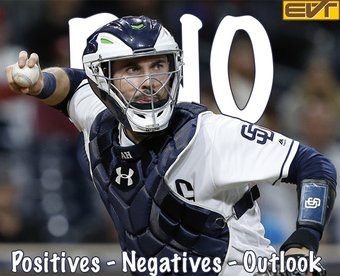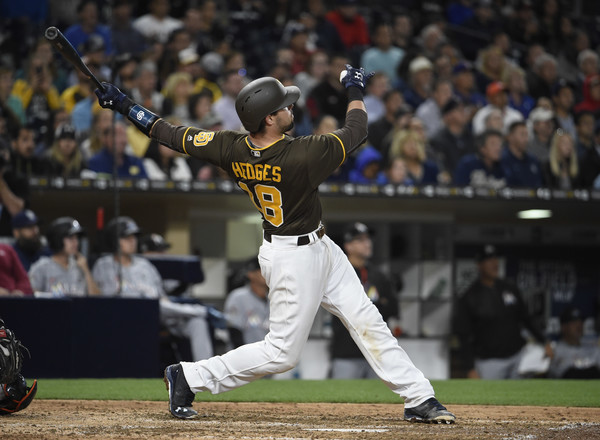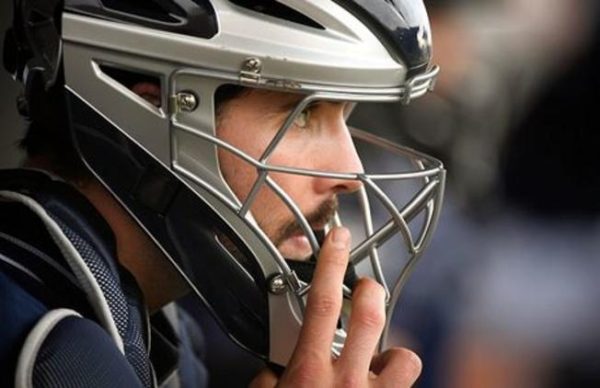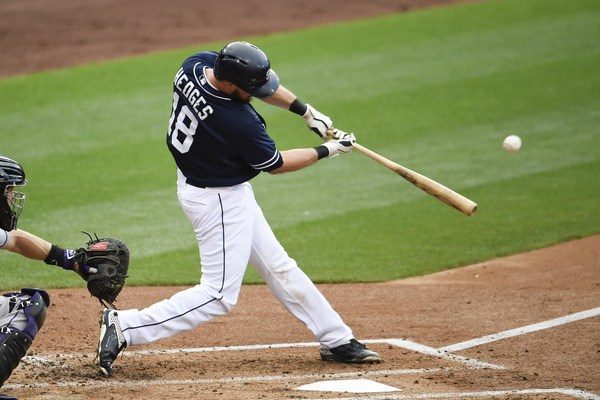PNO (Positives, Negatives, Outlook) Austin Hedges

Credit: EVT Sports

Going into the 2017 season, the Padres were counting on their first wave of prospects to show their talent and provide some hope for the future.
The trio of Manuel Margot, Hunter Renfroe, and Austin Hedges represented the best of that first wave of prospects, and their development was probably the biggest storyline of the 2017 season. However, those three weren’t without their struggles. While Margot was fairly consistent when he was healthy and on the field, both Renfroe and Hedges had their fair share of ups and downs over the course of the year.
Given the title of this article, Austin Hedges will be my focus. After languishing for many years in the minors with significant red flags, Hedges finally broke out in a big way with the Triple-A El Paso Chihuahuas in 2016, slashing .326/.353/.597 with a career-best 146 wRC+ in 82 games. Hedges did miss a significant amount of playing time with a broken bone in his hand, but he didn’t seem to miss a beat upon returning from injury. Despite running a wRC+ in the 60 range in both 2014 and 2015 in Double-A, Hedges reached a new level of offensive performance in his second go at Triple-A in 2016 following a disappointing MLB debut in 2015. In that 137 at-bat stretch at the big league level in 2015, Hedges ran a 26 wRC+ and batted .168 with a .215 on-base percentage.
Despite the questions about his offensive performance, there haven’t really been any questions about his work behind the plate. While he was in the minors, Hedges was widely viewed as one of the best defensive catchers in the entire minor leagues. Upon his call-up to the big leagues, Hedges rightfully took his place on catcher defense leaderboards, even with his poor offensive performance. Hedges took that strong defense to an even higher level with his performance in the 2017 season. Going forward into 2018 and beyond, Hedges’ future is going to depend on how his offensive profile progresses as he gets more major league experience under his belt.
Positives
Gold Glove Caliber Defense
To begin or end any conversation about Austin Hedges, defense has to be mentioned. While he wasn’t immediately viewed as a stellar defensive prospect in his early minor league career, Hedges came to be known as one of the best defensive catchers in all of minor league baseball. With above average framing skills and one of the best pop times around, not to mention his apparent talent for calling a game behind the plate, it was easy to see Hedges as a fantastic defensive catcher. Upon entering the big leagues full time in 2017, Hedges did not disappoint from a defensive standpoint.
According to StatCorner, among players with at least 5,000 total pitches caught (Hedges had 8,000 total pitches caught), Hedges ranked third in baseball with an 18.1 runs above average (RAA). Runs above average is an attempt to quantify how many positive or negative runs a catcher contributes to his team over the course of the season. Given that each win is valued at about 10 runs, Hedges provided about two wins to his team in his catch framing value alone. Beyond that, Hedges also collected 136 plus calls, good for third in all of baseball with the same sample size listed above. So by both these catcher framing metrics, Hedges is represented as one of the best catchers in the game.

To take it a step further, Hedges also ranks very well on Baseball Prospectus’ catcher leaderboards. For the 2017 season, Hedges ranked behind only Tyler Flowers with 20.8 framing runs, which puts him on par with his StatCorner numbers. In addition, Hedges found himself at the top of the FRAA leaderboards as well (that stands for framing runs above average) at 29.8 framing runs. So all in all, pretty much all of the numbers back up Hedges’ elite defensive skills. Despite being a negative at the plate, Hedges still was rated as the 61st-best player in baseball by BP’s WARP metric due to his defensive value. In terms of pitch framing, blocking, receiving, controlling the bases, and calling a game, Hedges is certainly in some elite company.
Power
Although Hedges is mostly a negative at the plate, he does have one important skill that could lead him to some offensive relevance long term: power. After bashing a career-high 21 long balls in just over 300 at-bats in Triple-A El Paso last year, Hedges bashed another 18 in his first full season in the big leagues in just under 400 at-bats. More importantly, Hedges sported a .183 ISO, putting him above the National League average of .169. This looks even better given the state of the catching position, especially given the league average ISO for catchers falls even lower at .159. This places Hedges seventh among the 16 catchers with at least 400 plate appearances in 2017. Obviously, this means his power isn’t elite, but he certainly has 25 to 30 home run potential with another 100 or so at-bats in a full season.
Negatives
Plate Discipline
The glaring issue for Austin Hedges is his poor plate discipline. In his first full season of big league action, Hedges sported a walk rate under six percent to go along with a strikeout rate just shy of 30 percent. Beyond that, Hedges swinging strike percentage sat at 16 percent while his O-swing percentage sat at 37.7 percent, both of which put him below the league average numbers. Pitchers consistently worked Hedges with pitches outside of the zone, getting him to chase for strikeouts and weak contact. Hedges was more than capable of turning on bad pitches left in the zone, but he was unable to lay of off-speed offerings out of the zone.
According to Brooks Baseball, Hedges is rated as having an exceptionally aggressive approach at the plate with a high likelihood to swing and miss on off-speed pitches. The two biggest culprits were changeups and sliders, as Hedges swung and missed at over 30 percent of changeups faced and nearly 26 percent of sliders faced. Looking further at his slash numbers, it becomes pretty apparent just how much Hedges struggled against those off-speed pitches. Hedges did fairly well with variations of fastballs, including straight fastballs, sinkers, and cutters, but struggled with changeups and sliders. Hedges batted just .191 against changeups while batting a mere .117 against sliders. Once pitchers got ahead of Hedges, their overall slider usage jumped up to 26 percent– that is for right-handers facing Hedges with two strikes or ahead in the count. It was pretty clear what Hedges’ weaknesses at the plate were, and pitchers were jumping at the opportunity.

Contact Issues
A logical extension of his plate discipline issues, Hedges also has some pretty substantial contact issues. When you are swinging and missing as much as Hedges was, contact is bound to be a problem, but it became an even bigger problem for Hedges because the contact he was making wasn’t the best. Sure, he had his share of hard-hit balls throughout the season, but his overall performance left a lot to be desired.
While Hedges did make hard contact over 30 percent of the time, he also made soft contact over 20 percent of the time, which limited his offensive upside. When Hedges wasn’t striking out, he was more often than not hitting the ball either weakly, or not as solidly as possible. Beyond that, Hedges sported a ground ball rate in the mid-30’s and an infield fly rate above 15 percent, both of which further limited his offensive upside. If Hedges made more consistent hard, line drive and fly ball contact, he may have fared better at the plate in 2017. Finally, and perhaps most critically, Hedges’ weighted on-base average (wOBA) sat a full .25 points above his expected weighted on-base average (xWOBA), meaning he had more success at the plate than he should have based on his quality of contact.
Outlook
To sum it all up, there is a lot to like about Austin Hedges, and a lot to be wary of. Depending on who you ask, Hedges has the potential to be one of the best catchers in baseball, or one of the biggest offensive liabilities in baseball. Truth be told, there is probably some truth to both of those arguments. Hedges certainly looks capable of playing gold glove-caliber defense for years to come, but his offensive game leaves a lot to be desired. If Hedges is unable to tap into more offensive potential beyond just his power, he may continue to be punchless at the plate. Regardless of whether or not that happens, Hedges should remain one of the brightest young catchers in all of baseball based on his stellar defense, at least for the foreseeable future. For a team with a plethora of young pitchers on the horizon, that is just what the Padres need out of Hedges.
Editorial and Prospect Writer for East Village Times. Twenty-five years young, Patrick has lived in San Diego for his entire life and has been a Padres fan nearly as long. Patrick lives for baseball and is always looking to learn new things about the game he loves through advanced stats.
Well written. And yeah, while power is great, it means nothing when you’re hitting your weight and can’t scrounge an OPB above .300 consistently. This is my main concern for Hedges, Renfroe, and apparently now, Mr. Myers. Not a good sign for the coaching in this organization. It’s also interesting how guys from other organizations can come in and produce and play solid baseball. Player development is everything, as is good coaching. Just ask the Cards who apparently understood how to make a mediocre hitter named Gyorko produce… 😛
I suppose my point of contention is pretty simple- it doesn’t really matter how good Hedges is defensively, his offense cannot be a liability. I think he has the tools but watching Wil regress and him and Hunter swinging for the moon is really not a good sign. God I hope Stairs knows what he’s doing…..